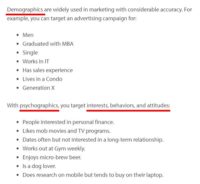A few years ago, many disruptionistas predicted that ad blockers would kill digital ads.
I pooh-poohed their predictions.
TV survived DVR. Web will survive ad blockers.
— Ketharaman Swaminathan (@s_ketharaman) November 6, 2015
Sorry to say I told you so but I was right:
- Digital ads are alive and kicking
- During this period, digital surpassed TV as the #1 ad channel
- Leading AdTech companies like Google and Facebook have grown by leaps and bounds in revenues, profits and market capitalizations in the meanwhile.
By now, most Netizens have reconciled themselves to seeing digital ads as they surf the web or tap through mobile apps. To that extent, rants against ads in general have come down.
However, from time to time, somebody or the other will whine about the nature of the specific ads they’re shown as they roam the Internet.
Take the author of Apple Takes A Stand On Privacy, Why It Matters To Retailers. Paula’s chief crib is that the Google Retargeted Ads and Facebook Ads she sees are absolutely out of sync with her preferences.
She’s not wrong but the term “preference” is highly nuanced. It doesn’t mean what she – or most of us – think it does.
In this post, we’ll unpack preference in the context of digital advertising.
Google Retargeted Ads
 I’m amazed that the controversy over Retargeted Ads simply refuses to die down!
I’m amazed that the controversy over Retargeted Ads simply refuses to die down!
For the uninitiated, Retargeted Ads are ads for brands that chase you all over the Internet after you’ve visited their websites or googled them. More at Retargeted Ads Or Retarded Ads?.
The author claims that consumers hate retargeted ads i.e. have strong negative preference for them.
That strongly dissonates with our experience of running retargeted ad campaigns and reams of anecdata on the topic.
For one, if consumers really hated retargeted ads, they wouldn’t be clicking them. But clicking them they are – in truckloads – out of their free will and volition.
For another, a very small fraction of consumers has asked us to turn off retargeted ads. I even know some people who treat Retargeted Ads as bookmarks to remind them of things they wish to buy when they’re not quite ready to buy them.
Retargeted ads are supposedly reviled by consumers but that hasn’t stopped them from delivering big bang for the buck.
Retargeting gives us the highest ROAS of all digital channels we use.
– Vice President (Marketing), Leading Airline
But that’s not to say that retargeted ads can’t get better. They can and are. More on that in a bit.
Facebook Ads
Facebook showed ads of Rush Limbaugh, Donald Trump, Ted Cruz, and other notables to the author of the aforementioned article, Paula.
When she clicked the “Why am I seeing this ad?” link on the ad, Facebook informed her that “the ads were being served based on my preferences.”
Paula insists that she has no preference for these people and insinuates that Facebook is lying.
It’s not. It’s more like Paula is not in sync with the term preference as it’s used by Facebook.
 The way ads work on Facebook, advertisers – not Facebook – get to decide whom their ads are targeted at. Advertisers specify demographic and psychographic attributes of people whom Facebook should show their ads to (see exhibit at left for examples).
The way ads work on Facebook, advertisers – not Facebook – get to decide whom their ads are targeted at. Advertisers specify demographic and psychographic attributes of people whom Facebook should show their ads to (see exhibit at left for examples).
Accordingly, an advertiser can set up a campaign where it specs its target audience as “fans of Ted Cruz”.
If a given user has set her preference – or Facebook has inferred her preference via its algorithms – as “Ted Cruz Hater”, she will not be shown ads from this campaign (say Campaign A).
Problem solved? Nope.
Because the same advertiser can set up another campaign (say Campaign B) where it specs its target audience to be “Ted Cruz Hater”. Facebook will show ads from Campaign B to this user since she’s not a fan of the said notable. Of course, after seeing the ad, she can always click on it and tell Facebook to turn it off. If she does that, Facebook generally ensures that she will stop seeing the ad in future. But she will see it once.
So, a given user will see some Ted Cruz ads and will not see some other Ted Cruz ads – regardless of her preference.
Now, to ratchet the complexity up by a notch, let’s consider the Lookalike Audiences feature in Facebook Ads. Here, the Advertiser tells Facebook that it wishes to target users who share certain common attributes with its existing consumers e.g. likes skiing, etc. Facebook selects users who have the said attributes and puts them into the target audience of the campaign.
The selected people need not be friends – or even familiar – with the cohort of the advertisers’s existing customers. They just happen to share some attributes in common with them, that’s all. As we can see, the attribute “likes skiing” has nothing to do with users’ preference vis-à-vis Ted Cruz.
Everybody placed in the target group will see Ted Cruz ads from both campaign A and campaign B, regardless of their preferences. Again, as before, they can ask Facebook to turn off the ads in future but they will see the ads once.
In short, Facebook Ads are targeted on the basis of the advertiser’s specifications regarding consumer preferences. To distinguish it from the consumer’s own preferences, we’ll call this Meta Preferences. (Pun not intended – I swear that I wrote this post before Facebook rebranded as Meta.)
As an aside, Facebook reserves the right to approve or reject advertisers’ specifications based on regulations and other factors e.g. An advertiser might wish to target its jobs ad campaign only at men. But, since job ads can’t discriminate on gender by law, Facebook will likely not approve the advertiser’s specifications.
Parallels with Email and Cold Call
As an aside, this resembles cold email and cold call campaigns.
This blog does not provide legal advice but, from my cursory knowledge of CAN SPAM law, a marketing agency can send its first email or make its first cold call to anyone in a business in USA. I read in a novel (Nature Girl by Carl Hiaasen) that the right of a salesperson to call a prospective customer is protected under the Fifth Amendment of the US Constitution.
It’s only from its second email and second cold call that the agency will need to incorporate the customer’s preference, if he has stated any explicitly.
Just Because Advertisers Can…
Everything in this post speaks to the propriety of the advertiser to show its ad to a particular user.
Some of you might be wondering, “just because an advertiser can show an ad doesn’t mean it should show its ad to disinterested users”.
That’s a fair point and will be the subject of a follow-on post. Watch this space!
